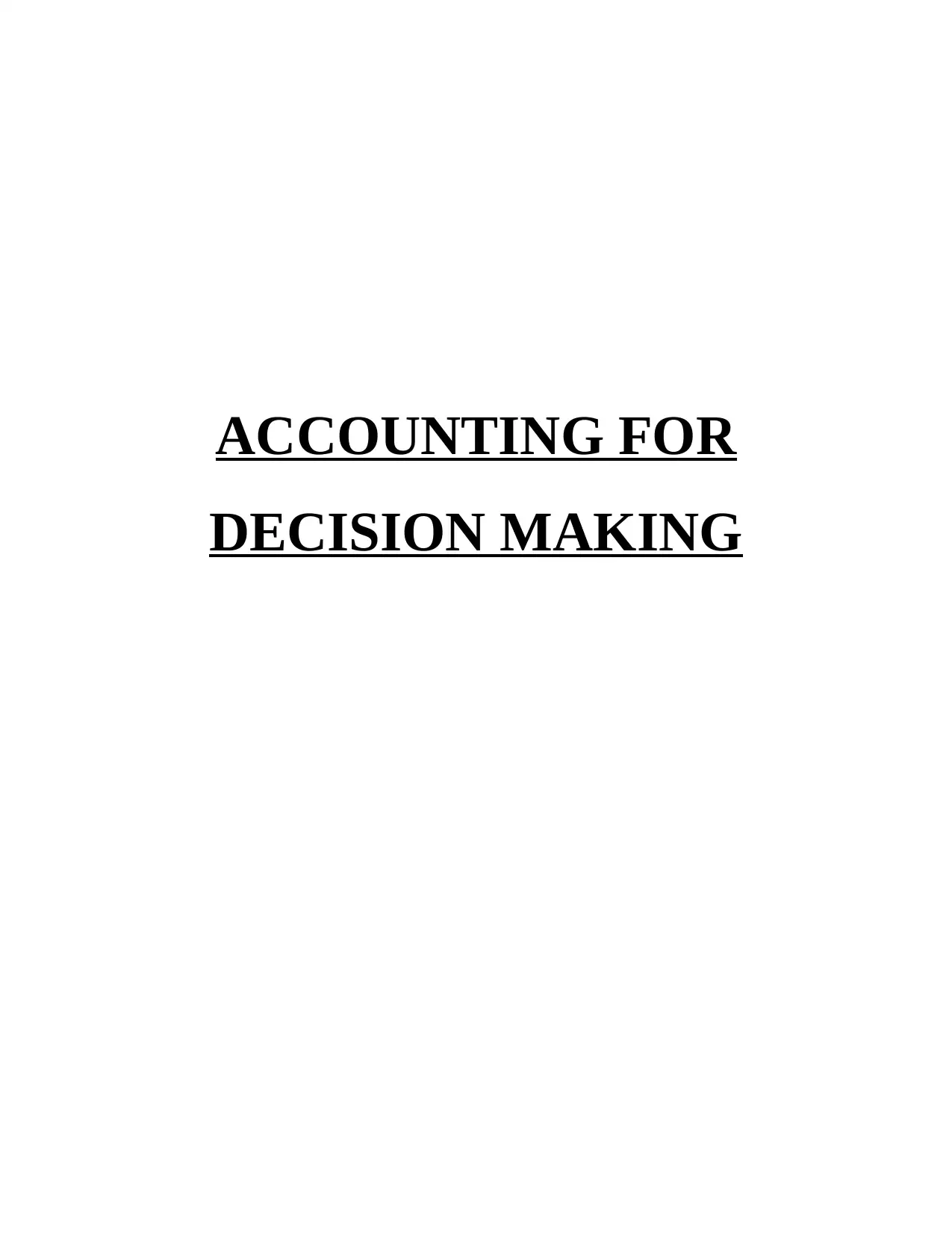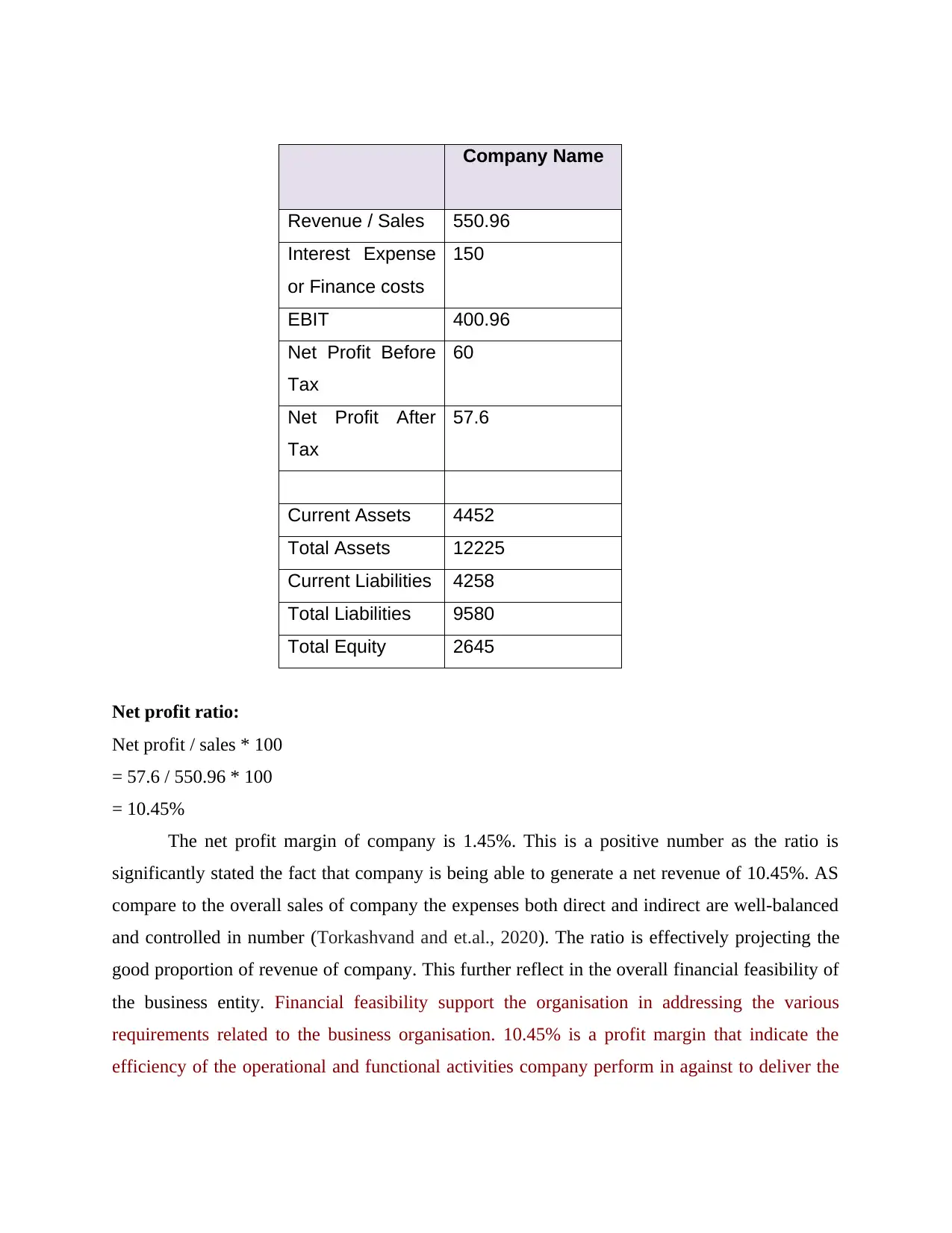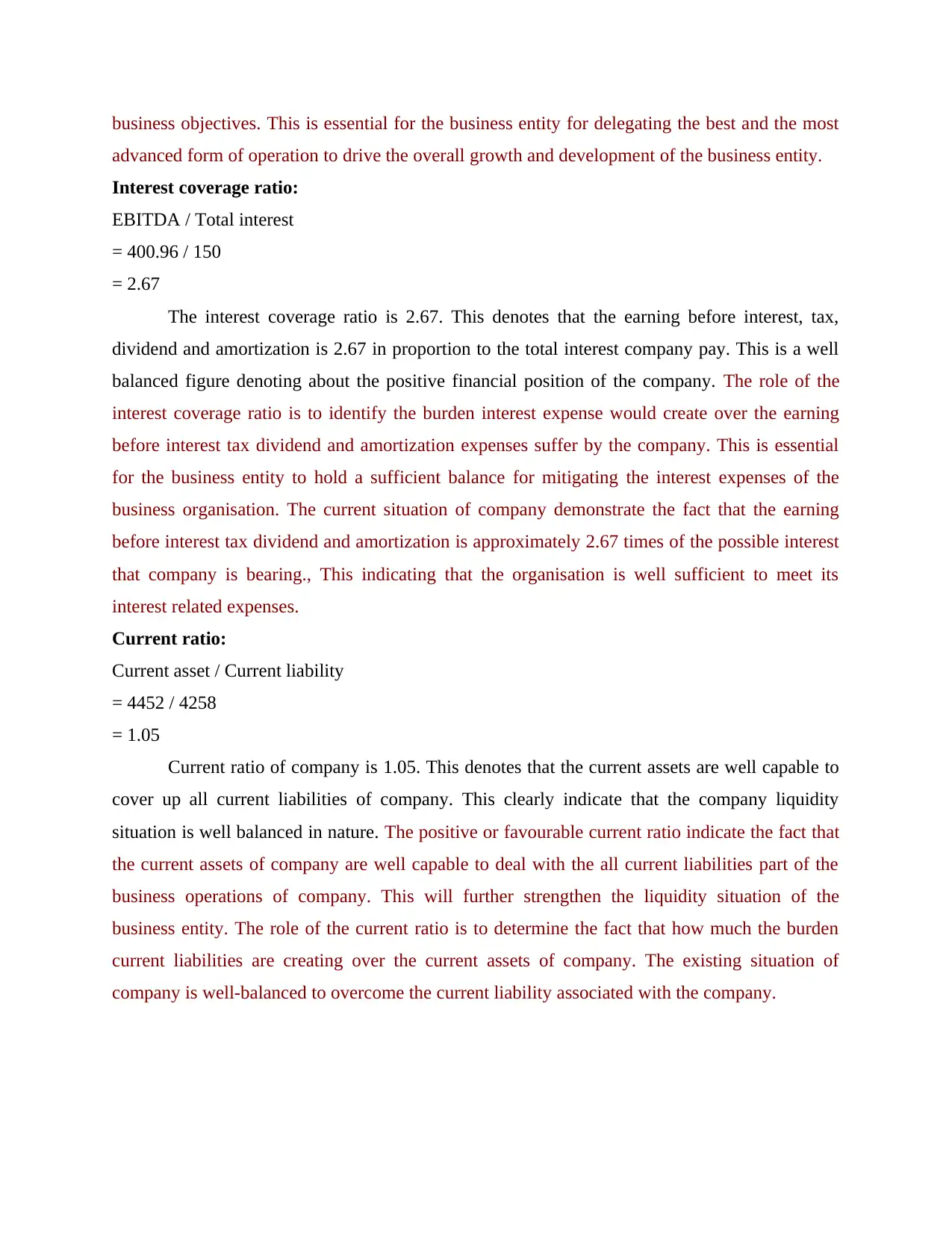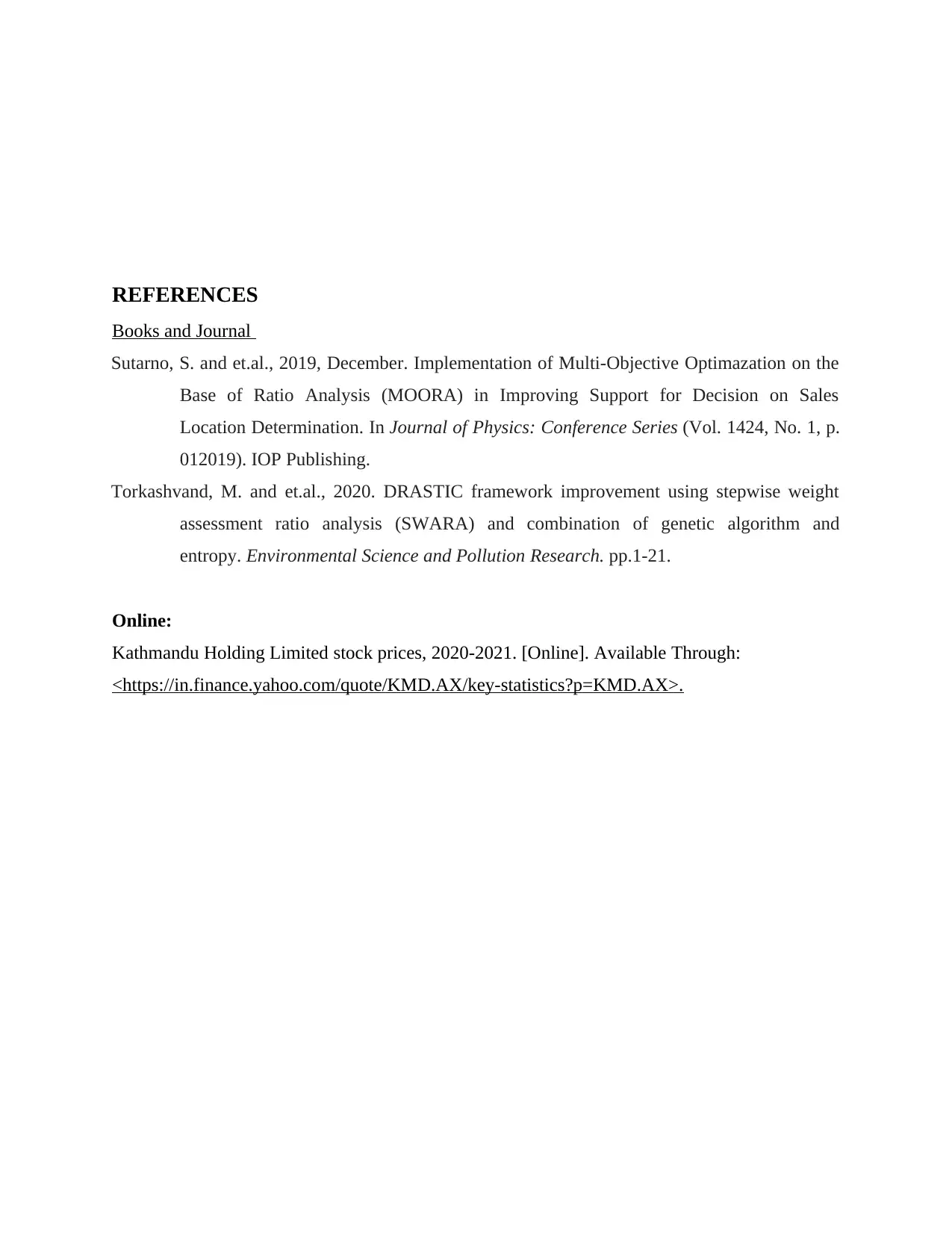BAO1101 Accounting: Decision Making in the Share Market, VU
VerifiedAdded on 2023/06/18
|6
|944
|205
Report
AI Summary
This report provides an analysis of decision-making in the share market, focusing on accounting principles and financial analysis. It examines Kathmandu Holding Limited's financial performance, including revenue, interest expense, and net profit, to assess the company's financial health and stock price fluctuations. The report calculates and interprets key financial ratios such as net profit margin, interest coverage ratio, and current ratio to evaluate the company's profitability, solvency, and liquidity. The analysis concludes that Kathmandu Holding Limited demonstrates a positive net profit margin, sufficient interest coverage, and a balanced liquidity position, indicating overall financial feasibility. Students can find similar solved assignments and past papers on Desklib.

ACCOUNTING FOR
DECISION MAKING
DECISION MAKING
Paraphrase This Document
Need a fresh take? Get an instant paraphrase of this document with our AI Paraphraser

Table of Contents
Part 2................................................................................................................................................3
Part 3................................................................................................................................................3
REFERENCES................................................................................................................................6
Part 2................................................................................................................................................3
Part 3................................................................................................................................................3
REFERENCES................................................................................................................................6

Part 2
Kathmandu Holding Limited is an organisation engaged selling retail product. Company
engaged selling outdoor and travel apparel and gear and accessories. Jan Cameron and John
Pawson is the founder of company. Headquarter of the company is based in New Zealand.
Xavier Simonet is the CEO of the company. The salary of the CEO is 5000000 Per Annum
(Sutarno and et.al., 2019). Company has earned a revenue of NZ$550.96 million that is further
detected as a net revenue of NZ$57.6 million. Company is currently employing to 1144 people at
different designation position in the organisation. Dividend per share is NZ$2.5.
The stock price of the company was keep on changing every single day. In the stock
market the prices are 3.56 in the initial stage of February 2020. That is further decreased in the
initial stage of march with the price of 2.05 that went to a decline of .78 in the month of April.
Initial stage of may quoted the price of .78 that goes up by 1.06 in the month of June. July was
the month of year 2020 the price became 1.14 that could decline slightly in august with the price
of 1.11, October was the month when the price was 1.23 that is further in November the price
become 1.15. The December month the closing price was 1.23. Initial time of January the price is
1.27 that is further end in February with the price of 1.28. This can clearly noted the fluctuating
trend in closing price.
Part 3
Revenue analysis
Kathmandu Holding Limited is an organisation engaged selling retail product. Company
engaged selling outdoor and travel apparel and gear and accessories. Jan Cameron and John
Pawson is the founder of company. Headquarter of the company is based in New Zealand.
Xavier Simonet is the CEO of the company. The salary of the CEO is 5000000 Per Annum
(Sutarno and et.al., 2019). Company has earned a revenue of NZ$550.96 million that is further
detected as a net revenue of NZ$57.6 million. Company is currently employing to 1144 people at
different designation position in the organisation. Dividend per share is NZ$2.5.
The stock price of the company was keep on changing every single day. In the stock
market the prices are 3.56 in the initial stage of February 2020. That is further decreased in the
initial stage of march with the price of 2.05 that went to a decline of .78 in the month of April.
Initial stage of may quoted the price of .78 that goes up by 1.06 in the month of June. July was
the month of year 2020 the price became 1.14 that could decline slightly in august with the price
of 1.11, October was the month when the price was 1.23 that is further in November the price
become 1.15. The December month the closing price was 1.23. Initial time of January the price is
1.27 that is further end in February with the price of 1.28. This can clearly noted the fluctuating
trend in closing price.
Part 3
Revenue analysis
⊘ This is a preview!⊘
Do you want full access?
Subscribe today to unlock all pages.

Trusted by 1+ million students worldwide

Company Name
Revenue / Sales 550.96
Interest Expense
or Finance costs
150
EBIT 400.96
Net Profit Before
Tax
60
Net Profit After
Tax
57.6
Current Assets 4452
Total Assets 12225
Current Liabilities 4258
Total Liabilities 9580
Total Equity 2645
Net profit ratio:
Net profit / sales * 100
= 57.6 / 550.96 * 100
= 10.45%
The net profit margin of company is 1.45%. This is a positive number as the ratio is
significantly stated the fact that company is being able to generate a net revenue of 10.45%. AS
compare to the overall sales of company the expenses both direct and indirect are well-balanced
and controlled in number (Torkashvand and et.al., 2020). The ratio is effectively projecting the
good proportion of revenue of company. This further reflect in the overall financial feasibility of
the business entity. Financial feasibility support the organisation in addressing the various
requirements related to the business organisation. 10.45% is a profit margin that indicate the
efficiency of the operational and functional activities company perform in against to deliver the
Revenue / Sales 550.96
Interest Expense
or Finance costs
150
EBIT 400.96
Net Profit Before
Tax
60
Net Profit After
Tax
57.6
Current Assets 4452
Total Assets 12225
Current Liabilities 4258
Total Liabilities 9580
Total Equity 2645
Net profit ratio:
Net profit / sales * 100
= 57.6 / 550.96 * 100
= 10.45%
The net profit margin of company is 1.45%. This is a positive number as the ratio is
significantly stated the fact that company is being able to generate a net revenue of 10.45%. AS
compare to the overall sales of company the expenses both direct and indirect are well-balanced
and controlled in number (Torkashvand and et.al., 2020). The ratio is effectively projecting the
good proportion of revenue of company. This further reflect in the overall financial feasibility of
the business entity. Financial feasibility support the organisation in addressing the various
requirements related to the business organisation. 10.45% is a profit margin that indicate the
efficiency of the operational and functional activities company perform in against to deliver the
Paraphrase This Document
Need a fresh take? Get an instant paraphrase of this document with our AI Paraphraser

business objectives. This is essential for the business entity for delegating the best and the most
advanced form of operation to drive the overall growth and development of the business entity.
Interest coverage ratio:
EBITDA / Total interest
= 400.96 / 150
= 2.67
The interest coverage ratio is 2.67. This denotes that the earning before interest, tax,
dividend and amortization is 2.67 in proportion to the total interest company pay. This is a well
balanced figure denoting about the positive financial position of the company. The role of the
interest coverage ratio is to identify the burden interest expense would create over the earning
before interest tax dividend and amortization expenses suffer by the company. This is essential
for the business entity to hold a sufficient balance for mitigating the interest expenses of the
business organisation. The current situation of company demonstrate the fact that the earning
before interest tax dividend and amortization is approximately 2.67 times of the possible interest
that company is bearing., This indicating that the organisation is well sufficient to meet its
interest related expenses.
Current ratio:
Current asset / Current liability
= 4452 / 4258
= 1.05
Current ratio of company is 1.05. This denotes that the current assets are well capable to
cover up all current liabilities of company. This clearly indicate that the company liquidity
situation is well balanced in nature. The positive or favourable current ratio indicate the fact that
the current assets of company are well capable to deal with the all current liabilities part of the
business operations of company. This will further strengthen the liquidity situation of the
business entity. The role of the current ratio is to determine the fact that how much the burden
current liabilities are creating over the current assets of company. The existing situation of
company is well-balanced to overcome the current liability associated with the company.
advanced form of operation to drive the overall growth and development of the business entity.
Interest coverage ratio:
EBITDA / Total interest
= 400.96 / 150
= 2.67
The interest coverage ratio is 2.67. This denotes that the earning before interest, tax,
dividend and amortization is 2.67 in proportion to the total interest company pay. This is a well
balanced figure denoting about the positive financial position of the company. The role of the
interest coverage ratio is to identify the burden interest expense would create over the earning
before interest tax dividend and amortization expenses suffer by the company. This is essential
for the business entity to hold a sufficient balance for mitigating the interest expenses of the
business organisation. The current situation of company demonstrate the fact that the earning
before interest tax dividend and amortization is approximately 2.67 times of the possible interest
that company is bearing., This indicating that the organisation is well sufficient to meet its
interest related expenses.
Current ratio:
Current asset / Current liability
= 4452 / 4258
= 1.05
Current ratio of company is 1.05. This denotes that the current assets are well capable to
cover up all current liabilities of company. This clearly indicate that the company liquidity
situation is well balanced in nature. The positive or favourable current ratio indicate the fact that
the current assets of company are well capable to deal with the all current liabilities part of the
business operations of company. This will further strengthen the liquidity situation of the
business entity. The role of the current ratio is to determine the fact that how much the burden
current liabilities are creating over the current assets of company. The existing situation of
company is well-balanced to overcome the current liability associated with the company.

REFERENCES
Books and Journal
Sutarno, S. and et.al., 2019, December. Implementation of Multi-Objective Optimazation on the
Base of Ratio Analysis (MOORA) in Improving Support for Decision on Sales
Location Determination. In Journal of Physics: Conference Series (Vol. 1424, No. 1, p.
012019). IOP Publishing.
Torkashvand, M. and et.al., 2020. DRASTIC framework improvement using stepwise weight
assessment ratio analysis (SWARA) and combination of genetic algorithm and
entropy. Environmental Science and Pollution Research. pp.1-21.
Online:
Kathmandu Holding Limited stock prices, 2020-2021. [Online]. Available Through:
<https://in.finance.yahoo.com/quote/KMD.AX/key-statistics?p=KMD.AX>.
Books and Journal
Sutarno, S. and et.al., 2019, December. Implementation of Multi-Objective Optimazation on the
Base of Ratio Analysis (MOORA) in Improving Support for Decision on Sales
Location Determination. In Journal of Physics: Conference Series (Vol. 1424, No. 1, p.
012019). IOP Publishing.
Torkashvand, M. and et.al., 2020. DRASTIC framework improvement using stepwise weight
assessment ratio analysis (SWARA) and combination of genetic algorithm and
entropy. Environmental Science and Pollution Research. pp.1-21.
Online:
Kathmandu Holding Limited stock prices, 2020-2021. [Online]. Available Through:
<https://in.finance.yahoo.com/quote/KMD.AX/key-statistics?p=KMD.AX>.
⊘ This is a preview!⊘
Do you want full access?
Subscribe today to unlock all pages.

Trusted by 1+ million students worldwide
1 out of 6
Your All-in-One AI-Powered Toolkit for Academic Success.
+13062052269
info@desklib.com
Available 24*7 on WhatsApp / Email
![[object Object]](/_next/static/media/star-bottom.7253800d.svg)
Unlock your academic potential
Copyright © 2020–2025 A2Z Services. All Rights Reserved. Developed and managed by ZUCOL.